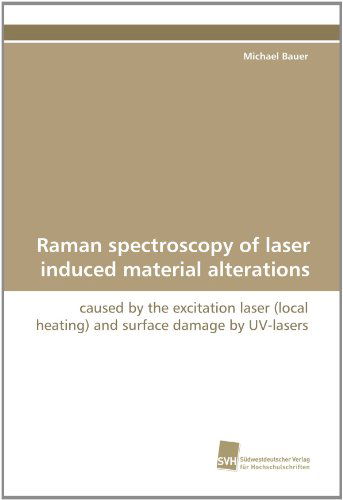
Tell your friends about this item:
Raman Spectroscopy of Laser Induced Material Alterations: Caused by the Excitation Laser (Local Heating) and Surface Damage by Uv-lasers
Michael Bauer
Raman Spectroscopy of Laser Induced Material Alterations: Caused by the Excitation Laser (Local Heating) and Surface Damage by Uv-lasers
Michael Bauer
Raman spectroscopy is a powerful tool for material characterisation. It can be used for the optical characterisation of mechanical stress in homogeneous samples, for material identification, and for compositional mapping. In addition, confocal Raman microscopy is useful for the measurement of stress fields generated, for example, by mechanical loading or residual stress after fabrication in silicon and silicon carbide. For precise stress measurements, the thermally induced shift of Raman peaks must be characterised in detail. In addition to external heating, the measurement itself may affect the sample temperature because the focused, intense light can locally heat the sample. Local heating must be taken into account to ensure reliable stress measurements, for example in silicon micro-structures. This information is important for optimising manufacturing processes and increasing the reliability of micro devices. Raman spectroscopy can also be used for compositional mapping of heterogeneous specimens or for the characterisation of material alterations, which can also be caused by the excitation laser itself.
| Media | Books Paperback Book (Book with soft cover and glued back) |
| Released | August 12, 2010 |
| ISBN13 | 9783838119496 |
| Publishers | Suedwestdeutscher Verlag fuer Hochschuls |
| Pages | 128 |
| Dimensions | 225 × 8 × 150 mm · 199 g |
| Language | English |
More by Michael Bauer
See all of Michael Bauer ( e.g. Paperback Book , Hardcover Book , Book and Sewn Spine Book )

 Christmas presents can be returned until 31 January
Christmas presents can be returned until 31 January


![Cover for Michael Bauer · Hverdagskærlighed (Paperback Book) [1st edition] (2024)](https://imusic.b-cdn.net/images/item/original/437/9788794349437.jpg?michael-bauer-2024-hverdagskaerlighed-paperback-book&class=scaled&v=1708685141)
![Cover for Michael Bauer · The Essential Guide to Lithium Treatment (Paperback Book) [Softcover reprint of the original 1st ed. 2016 edition] (2018)](https://imusic.b-cdn.net/images/item/original/922/9783319809922.jpg?michael-bauer-2018-the-essential-guide-to-lithium-treatment-paperback-book&class=scaled&v=1652735143)


![Cover for Michael Bauer · Cologne Spirit (Paperback Book) [German edition] (2015)](https://imusic.b-cdn.net/images/item/original/927/9783735761927.jpg?michael-bauer-2015-cologne-spirit-paperback-book&class=scaled&v=1408383476)




![Cover for Michael Bauer · Green Building: Guidebook for Sustainable Architecture (Book) [2010 edition] (2009)](https://imusic.b-cdn.net/images/item/original/340/9783642006340.jpg?michael-bauer-2009-green-building-guidebook-for-sustainable-architecture-book&class=scaled&v=1406811699)
![Cover for Michael Bauer · Stimmungsschwankungen Bei Kindern Und Jugendlichen (Paperback Book) [German edition] (2009)](https://imusic.b-cdn.net/images/item/original/926/9783837048926.jpg?michael-bauer-2009-stimmungsschwankungen-bei-kindern-und-jugendlichen-paperback-book&class=scaled&v=1408611848)

![Cover for Michael Bauer · Akute Und Therapieresistente Depressionen: Pharmakotherapie - Psychotherapie - Innovationen (Hardcover Book) [2., vollst. uberarb., erw. Aufl. edition] (2005)](https://imusic.b-cdn.net/images/item/original/174/9783540406174.jpg?michael-bauer-2005-akute-und-therapieresistente-depressionen-pharmakotherapie-psychotherapie-innovationen-hardcover-book&class=scaled&v=1425912347)


![Cover for Michael Bauer · Ermittlung Der Fliesskurven Von Feinblechen Im Ebenen Torsionsversuch - Ifu - Berichte Aus Dem Institut Fur Umformtechnik Der Universitat Stuttgart (Paperback Book) [German edition] (1989)](https://imusic.b-cdn.net/images/item/original/175/9783540511175.jpg?michael-bauer-1989-ermittlung-der-fliesskurven-von-feinblechen-im-ebenen-torsionsversuch-ifu-berichte-aus-dem-institut-fur-umformtechnik-der-universitat-stuttgart-paperback-book&class=scaled&v=1460409023)